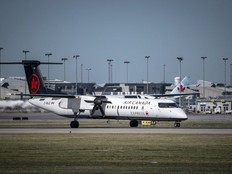'QUITE A NIGHTMARE': Windsor, auto sector brace for second wave of Trump tariffs

Article content
For decades, an integrated automotive industry has classified American and Canadian parts in one category, but that is in the process of changing in U.S. President Donald Trump’s potentially devastating second wave of attacks on automotive free trade.
The American government is working on creating a system by May 3 that would allow it to impose a 25 per cent tariff on non-American parts crisscrossing the North American borders between the three CUSMA (Canada, U.S., Mexico) trading partners.
Until that happens, all CUSMA-compliant parts won’t be tariffed.
“Even for the U.S. government, this is going to be challenging,” said Sam Fiorani, AutoForecast Solutions vice-president of global vehicle forecasting.
“They’ve been doing it this way for nearly 40 years.”
The Canadian government responded to the launch of auto tariffs Thursday by placing a 25 per cent tariff on vehicles imported from the U.S. that are not compliant with CUSMA. The tariff will also not apply to auto parts as the federal government tries to avoid heaping more misery on Canadian parts makers that could potentially put them out of business.
“Suppliers often have plants located on both sides of the border and they may have multiple sources for parts themselves,” Fiorani said. “That makes it even more difficult.”
Fiorani said creating a way to track everything from the tiniest screw to the components of more complex finished products like an engine, which can contain 1,200 individual parts, is likely going to create a whole new layer of bureaucracy.
The costs associated with collecting the tariffs will certainly erode the overinflated sums of new revenues Trump boasts of gathering.
“The president believes it’s going to make money,” Fiorani said.
“Finding a way to do that, with as many customs agents you’ll need, as many as accountants as you’ll need, it’s going to be very difficult to do it.
“That’s kind of the idea behind it. The idea is all parts and vehicles will be made on the U.S. side of the border.”
Those parts and vehicles will be more expensive
The costs of the program will come in addition to the tariffs impact in inflating prices for parts.
“All those parts and vehicles will be more expensive because the automotive industry has been designed in efficiencies between the three countries of USMCA to make everything work,” Fiorani said. “It was not designed for a sudden change in that plan.”
Designing a system to track and tariff a part will be the easier task in this endeavour, said Peter Frise, a University of Windsor professor of mechanical and automotive engineering.
Like the parts themselves, the materials and processes that go into creating each part also involves all three CUSMA partners.
“The problem is, and this could become very complicated — what is a Canadian part and what is an American part?” Frise said.
“Let’s say you’ve got a lower control arm that’s made of aluminum. The aluminum almost certainly came from Quebec. It may have gone to the states to be capped. It may go to Canada to have a ball joint pressed into it then go back to the states to be assembled into a car.
“They know what the part number is and who they bought it from, but they may or may not have the full history on where the material came from, where the processes were done and how much of the part’s value is taken on at each stage of those processes.
“I don’t know if the cars companies are going to be able to do that quickly.”
Frise added a car has 20,000 to 30,000 parts setting the stage for an enormous amount of paperwork and new costs to both the industry and government.
“It’ll be quite a nightmare to make this happen,” Frise said.
“It’ll be a costly endeavor. The American consumer is going to be paying between $3,000 and $20,000 more for a car.”
The parts companies and their suppliers don’t have the profit margins to eat additional costs of tariffs and related expenses, Frise added.
“They operate on thin margins and it doesn’t take much to push them into the red. If they can’t make money doing it, they won’t do it,” he said.
“Someone has to pay for it. The taxpayers will also pay the cost of the border services required.”
Because of the scale of the auto industry, it accounted for half of the US$2.4 trillion value of American manufacturing in 2024, said Fiorani, so the ripple effects of the tariffs will be far reaching.
“The American public doesn’t fully grasp, like the rest of us, how deep this will go,” he said. “It will hit more things with higher costs than the public is aware and likely higher than the government is explaining to the public.
“This year was going to be a tough year economically, anyway, adding this much cost to doing business in the U.S., leads us closer to a recession this year and unfortunately dragging other countries with us.”
The reality for the North American automotive industry is Trump’s tariffs are having an immediate negative impact.
Stellantis is laying off nearly 4,000 Windsor Assembly Plant workers for two weeks starting Monday, and 900 American workers at U.S. plants in Indiana and Michigan which supply their factories in Windsor and Mexico.
Cleveland-Cliffs, the largest supplier of steel to the U.S. auto industry, laid off 600 workers last week from its Dearborn, Mich., plant. It also laid off another 630 employees from two of its Minnesota iron ore mines, blaming lack of demand in the auto industry.
Going to cost more for anyone buying a vehicle — new or used
“It’s going to lower-profit margins on every vehicle and it’s going to cost more for anyone buying a vehicle, whether it’s new or used,” said Fiorani of the parts tariffs.
“It’s going to lower demand for new vehicles and raise the demand for used vehicles, which increases the price on both. With lower demand in the U.S. for these vehicles, it’s going to make the plants that make them less profitable.”
Fiorani added the tariffs will also reduce product selection with automakers, giving favour to more expensive vehicles with larger profit margins. Germany’s Mercedes Benz said this week it may have to pull its cheaper models from the U.S. market because of the tariffs.
“It will actually eliminate the under-$30,000 vehicle in the U.S,” Fiorani said. “It pushes everyone upscale.
“If people can’t afford a car now, they definitely won’t be able to afford one six months from now when that same vehicle will cost a bundle more.”
Twitter.com/winstarwaddell











Postmedia is committed to maintaining a lively but civil forum for discussion. Please keep comments relevant and respectful. Comments may take up to an hour to appear on the site. You will receive an email if there is a reply to your comment, an update to a thread you follow or if a user you follow comments. Visit our Community Guidelines for more information.